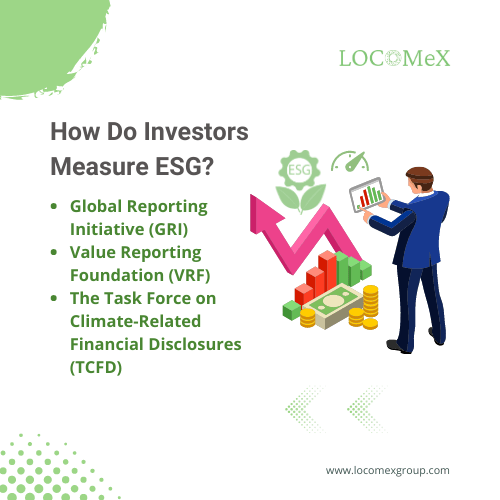The significance of Environmental, Social, and Governance (ESG) continues to rise. It has become a major area of concern for various stakeholders, especially investors because environmental and social issues constitute some of the most difficult challenges of the decade.
And if you want your firm to be sustainable, consider environmental, social, and governance metrics because investors use this ESG indicator to know how to invest money. In other words, an investment study can assist companies in assessing if investing money in a certain firm will have a beneficial, responsible effect.
Get the best project-based ESG risk-scoring tool from LOCOMeX to optimize your capability to meet your company’s ESG targets.
What Are Standard ESG Metrics?
- Environmental: ESG’s “E” stands for how companies control their environmental impact. This metric comprises a business’s carbon emissions, which can be divided into direct emissions (Scope 1), emissions from the acquisition and use of energy (Scope 2), and emissions from the supply chain (Scope 3). Also, greenhouse gas emissions, waste management, the company’s effect on air and water quality, energy efficiency, and deforestation are further environmental considerations. Check out LOCOMeX’s only project-based ESG risk scoring tool that provides auditable investment-grade ESG & scope 3 emission reporting data.
- Social: The “S” in ESG refers to how businesses treat their employees and the communities in which they operate. The social component of ESG also includes elements like employee involvement, inclusivity, gender diversity, data protection, labor standards, human rights, and community relations.
- Governance: The “G” in ESG stands for governance, which refers to a company’s internal control systems, policies, and methods for mitigating and responding to infractions. Company leadership, board diversity, the composition of the audit committee, shareholder rights, lobbying, executive compensation, whistleblower initiatives, ethical practices, political donations, and anti-corruption measures are all examples of governance aspects.
How Do Investors Measure ESG?
While a high emphasis is placed on sustainable investing, investors require precise methods to gauge ESG performance and pinpoint ESG risks to guide their investment decisions. By doing this, they intend to discover businesses with ESG-focused business models that will likely have positive long-term financial performance.
However, out of multiple frameworks, three of the most frequently used ESG reporting frameworks are:
Global Reporting Initiative (GRI)
The GRI was established in 1997 in response to public uproar over the environmental harm brought on by the Exxon Valdez oil spill. The goal was to establish the first accountability system to ensure businesses follow ethical guidelines for environmental behavior. Over time, this mission has expanded to cover social, economic, and governance challenges.
Investors utilize the voluntary GRI Sustainability Reporting Standards, introduced in 2016 by the GRI, to determine the best ESG performers while building their investment process. They aim to provide a flexible framework for developing a comprehensive ESG report, including tax, emissions, anti-corruption, biodiversity, and occupational health and safety.
Value Reporting Foundation (VRF)
In June 2021, the International Integrated Reporting Council (IIRC) and the Sustainability Accounting Standards Board (SASB) united to form the Value Reporting Foundation (VRF). The VRF is a multinational NGO that supports businesses in connecting data on finances, people, and sustainability.
The Task Force on Climate-Related Financial Disclosures (TCFD)
The TCFD, which the Financial Stability Board established, focuses its climate-related recommendations on four major pillars:
- Corporate Governance performance: Are the risks and possibilities associated with climate change considered in your organization’s governance structure?
- Strategy: How are you addressing the real-world effects of climate-related threats and opportunities? Do you have any funding plans in place to support these efforts?
- Risk management: How does your company define, examine, track, and manage risks related to climatic change?
- Metrics and Targets: What ESG metrics and measurements do you employ to evaluate significant climate-related risks and opportunities?

Additionally, the World Economic Forum (WEF) most recently published a set of “stakeholder capitalism metrics” in September 2020 to help to measure the ESG performance (including annual reports and sustainability reports) in their mainstream reporting materials. The measurements are based on four pillars that include a variety of ESG factors such as:
People: pay gaps, diversity reporting, and health and safety.
Planet: water consumption, greenhouse gas emissions, and land preservation.
Prosperity: Taxes paid, wealth generation, and costs associated with research and development expenses.
Principals of governance: The influence of purpose, strategy, and accountability on risk and moral behavior.
While the WEF encourages companies to include a wide range of measures, such as the the best project-based ESG risk scoring tool, in their corporate and financial reporting, certain of these criteria now, have greater weight with investors than others. Also, since these metrics are typically the easiest to measure and can be integrated into existing standards and frameworks, they are more likely to be included in annual reports.
Why Are ESG Metrics Important To Investors?
Investors are relying more and more on ESG metrics because
1. It provides transparency on a company’s financial and operational performance and how those companies handle a wide range of risks.
For instance, Apple has pledged to use only renewable energy and is currently carbon neutral. Apple saves more than $80 million annually by abandoning fossil fuels and utilizing renewable energy sources.
2. ESG metrics give investors a complete picture of a company’s performance, enabling them to make informed decisions for wiser investment choices.
For example, a company’s commitment to improving access to clean water for residents of underdeveloped communities is more likely to attract investors inclined to the same cause.
3. By choosing sustainability metrics and the best supplier software for diverse organizations, investors may ensure that their portfolios are ready for the adjustments necessary to make the world economy more sustainable, such as achieving net zero emissions by 2050.
How Can LOCOMeX Help?
The best supplier software for diverse suppliers and the ESG benchmarking tool from LOCOMeX are intended to transform data management digitally. It assists businesses in setting up a single repository for ESG data, making it quick and simple to gather, exchange, and utilize.
Plus, our platform guarantees that corporate ESG data, workflows, and reporting are efficient, auditable, and insightful, with clear guidance for decision-making. So, reach out to our experts now and explore our services.



